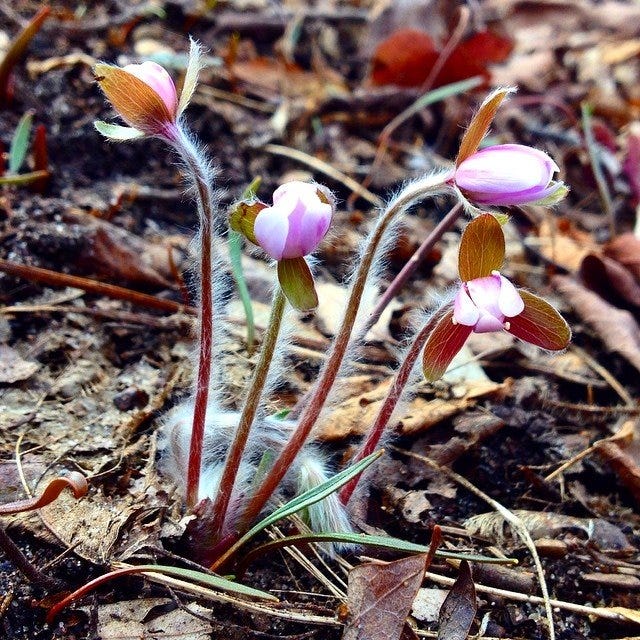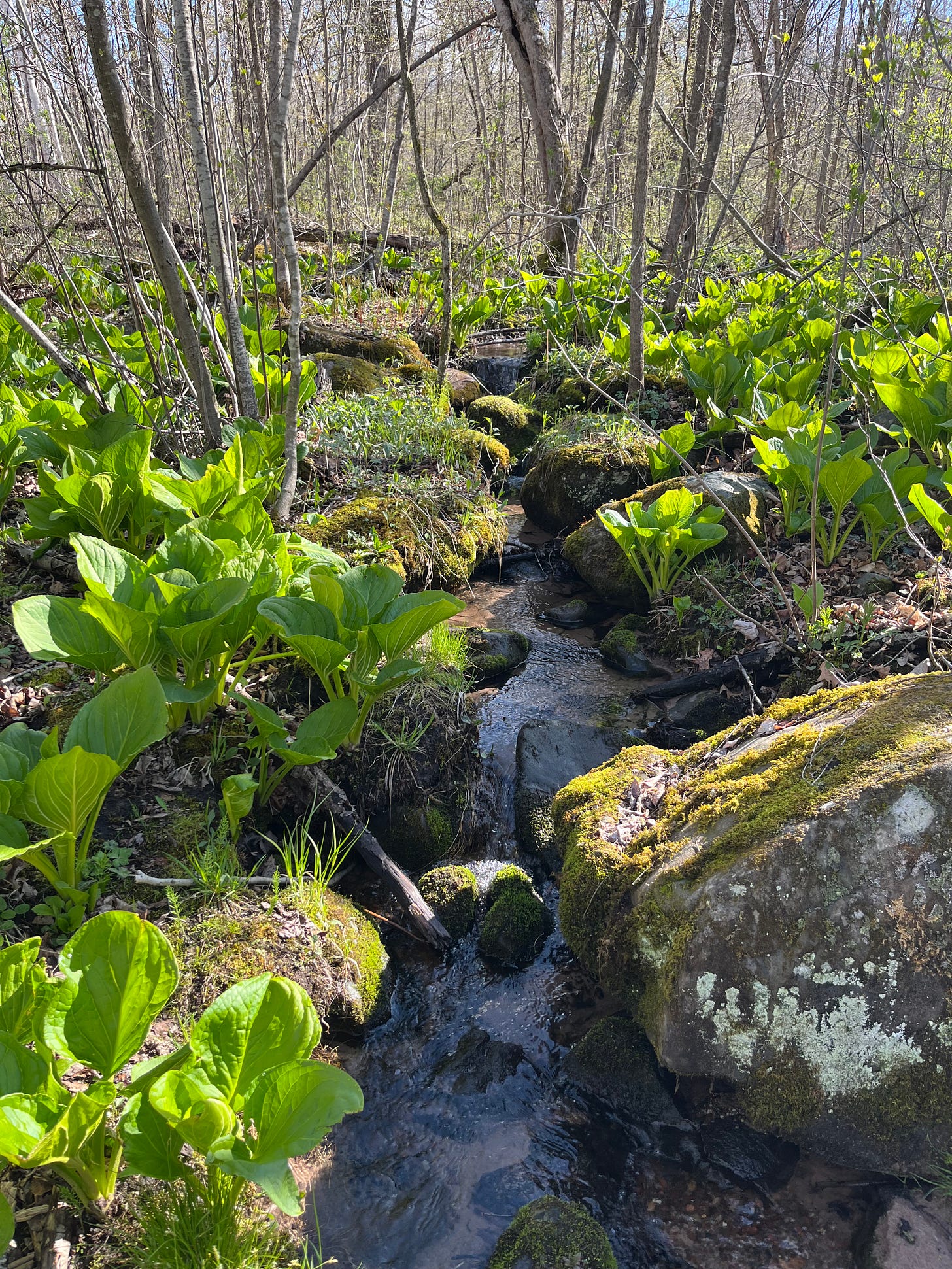It’s my favorite time of year on the Trail of Myths, which you’ll read about if you continue past this first paragraph. The spring ephemerals are popping up on the forest floor, skunk cabbage is just big enough to add splashes of vibrant green along the creek beds, and the air temperature is comfortable. I hadn’t been on this particular trail for several months, but this past weekend I was able to return. The following is an excerpted chapter from Collisions of Earth and Sky1, as inspired by the trail.
Walking slowly down a rocky trail in woods that seem to be breathing, I keep stopping to peer more closely at tiny plants and listen to the running water bubbling through the area in a maze of spring-fed streams en route to the larger St. Croix River. The forest floor has a carpet of hepatica, trillium, bloodroot, Dutchman’s breeches, and bellwort, a tangle of white, purple, yellow, and green as spring blooms open with the season. Adolescent skunk cabbage and uncurling ferns cast a tint of green as far as the eye can see, everything reaching toward the sun’s nourishment. It’s like a fairy tale woodland, and I find myself thinking that if there is such a thing as an enchanted forest, this must be it.2
This trail is one of several in a local nature preserve. Years ago, one of the park volunteers dubbed this particular pathway the Trail of Myths, and there is a certain energy here that invites questioning those unhelpful stories we talked about earlier—the myths that present in the form of false notions or mistaken beliefs. It’s a place requiring honesty, like the upstandingness of a blooming marsh marigold, bold and beautiful even there in the boggy parts of the forest that are too muddy to visit without courageous intention. A place to question and observe and take part in the true story that is being told with every passing moment, no matter what that moment presents. A place to look through myth into truth.
Ever since I lost a long-held corporate job, even though it was years ago, I think more than I would care to admit about money. Is there enough, how can there be just a little bit more, what expenses can be cut? What changes are required so there is always enough? Even after getting a new job, publishing some books, and continuing to simplify, the myth of money tells a story that is seductive: that it buys happiness, that having a little more would be better, that it is the source of life, that it could vanish in the blink of an eye. Next to money sits the myths of connectivity and growth: that it’s important to be vigilant and always connected, lest an opportunity be missed, always striding with confidence outside the comfort zone. Be afraid of missing out. All or nothing. Growth mindset or death. Attention and economy have melded—and not always for good.
Fortunately, this path through the forest reminds me of the wealth I hold in the form of time and access to wildness (which, of course, is a privilege as well): abundant trails just down the road, a National Scenic Riverway close by, the woodlands and marshes that also call this part of earth home. It reassures me that simply living in a way that makes me feel alive is good enough. That there is a time for growth, but there is also a time for stillness and decline. We could also call this the myth of scarcity, and it taunts with the allure of acquiring more: money, comfort, knowledge, validation—even if it means at a cost to time and access to wild spaces. It’s the myth that says, “No. Just living? Come on now. Just living is never enough. You have to always be striving. Growing. Reaching higher. Receiving praise in abundance.” Gentle reassurance from the forest sometimes wins out over taunts from what author Daniel Quinn called “Mother Culture,” but the choice of where to put my attention can be hard to make. Fantasy and fairy tale keep close quarters.
There’s something about sitting with moss or hopping over a rock-strewn creek to examine a tiny pink blossom that tells another tale, and it’s a storyline that aches to be followed more often. It’s the story of a person who lives a life steeped in noticing, a person who moves through days in a slow and intentional way. This person knows when to unplug from the machine to walk through waist-high prairie grass. This person pauses to look up at the sky on days when unplugging isn’t realistic. This person accepts hardships and muddles through whatever spectrum of emotion is needed. It’s a story that is more parable, less delusion. More fable, less fallacy. A fairy tale maybe—but a believable one. The world could use more believable fairy tales.
Any trail of myths, no matter what the story, is long and wind- ing, full of chances to wonder. There’s always something more to want, something more to achieve. Emotions are tempting to dodge if they aren’t desired. The twin allure of constant growth and 24/7 digital connection is as persistent as it is exhausting. The modern myths surrounding money and new technologies are not fairy tales, no matter how much the protagonist acquires, no matter how much attention is spliced in the name of productivity, no matter how glossy the cover of the storybook.
There was a time years ago, in college, when I thought, When I have a job and am out on my own, that’ll be enough. A few years later, sitting in my work cubicle during the day or in my studio apartment in the evenings, I thought, When I live in a real house and have a family, that’ll be enough. A few years later, gazing out the window of my little urban cottage, sitting across from my new spouse, I thought, When I live in a house in the country, on a lake, and hear nothing but birdsong in the morning, that’ll be enough. Several years after that, newly laid off, staring at Monster.com on my computer screen, tod- dler at my feet and birds chirping in abandon, I thought, When I find a new job, that’ll be enough. And just this year, as I work a pretty stable job from home in my kitchen, sliding door to the back open, birdsong in full spring jubilation as the sun glints off the water, still I think, When I can make just a little bit more money, fix a few more things on the house, figure out how to balance all these new technologies that want my attention, and not have to work so many hours at my day job, that’ll be enough. Enough can be elusive.
As I round the bend near the halfway point on the Trail of Myths loop, I stop again, this time to examine an outcropping of mushrooms that has popped up on an enormous, decaying, moss-covered stump. White trillium dances in the breeze as warm air lifts hair from my neck, and I think to myself, When I can figure out how to truly appreciate the experience of a spring woodland, that’ll be enough.
One internal myth that’s common for many is that contentment and satisfaction will be just around the next corner. Yet there’s always another corner. There is no arriving one day, finally satisfied, finally worry free, finally perfectly balanced, finally in the desired place. There is just each moment as it unfolds. There is just being present to experience the days, no matter what might still seem lacking. No matter how often what seems like enough shifts to longing.
It is a tangled trail, but when I can believe that doing the good work of living is enough, it is. When I live and work in ways that fill me up, even when circumstances are challenging, jobs are lost, new jobs don’t pay all of the bills, thoughts around money feed fears, technology splices attention into little bits, and the thought of growing even one more inch is too exhausting to fathom, just living is still enough. When I operate from a foundation of compassion for self and others, when I accept with tenderness my own vulnerabilities, when I look failure in the eye and see it not as a deep well of despair but a chance to shift course or add another layer of resiliency, then that good work, that way of living is enough. Some trails lead toward myths that help me lean into what is enough for a life well lived, and some trails don’t. I intend to stay on the route toward wholehearted aliveness, always returning to it when I find myself stumbling down an unmarked trail into thorns.
In this midwestern forest, a humble woodland trail has the power to unravel the myth of not being enough. It challenges the myth of never arriving, and it challenges the myth of finally getting there. After all, there is no arriving—there is only the journey and being present for it.
If there ever was an enchanted forest, this must surely be it.
I wrote the original of this piece as a submission to Orion Magazine several years ago. They kindly declined its publication, but I kept working on it. It found a home at A Life in Progress, and then eventually, into a book. So, don’t discount those rejected essays, writers—you never know where they might find a home someday.
If you’d like to “Hike the Book” you can get a whole itinerary at The Landscaper’s Daughter.
Itinerary includes instructions, a route map, history highlights, food/drink suggestions, little-known facts, and more: everything you need for a fun day out – already researched and planned for you! It also includes suggestions for places to stay and additional fun activities. Copy of Collisions of Earth and Sky not included but many local libraries have copies available to check out.








It all seems so - mythical…
Photos are lovely, a picnic of pictures reminding us of how delicious spring can be.
Thank you
Just the right note for a quiet walk in local woods & flowering fields...will head out soon, and as you say, it will be enough. Thank you!